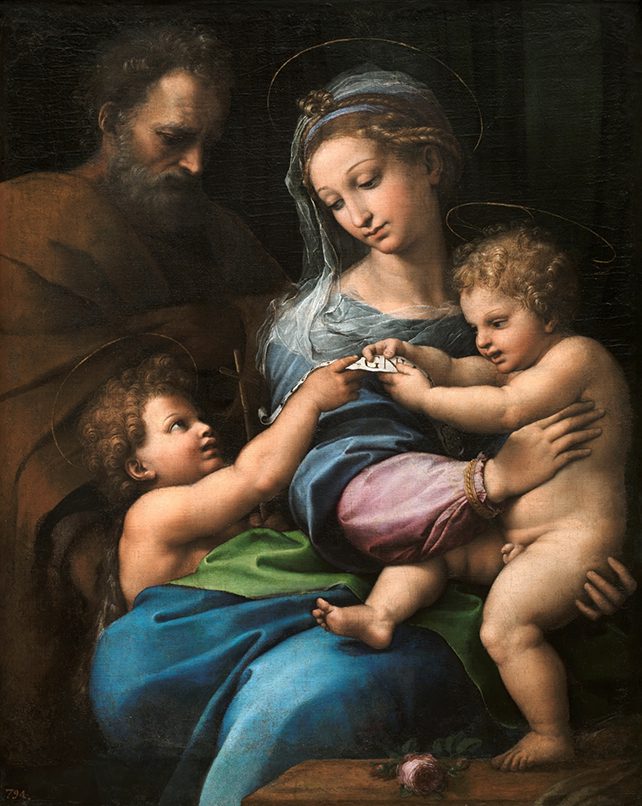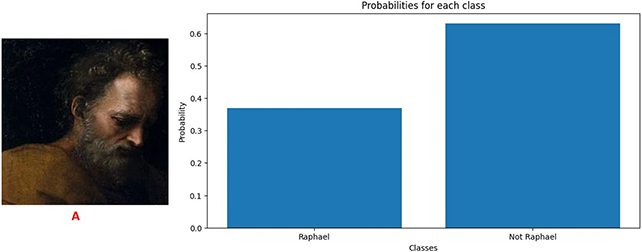TL;DR:
- AI neural network identifies discrepancies in Raphael’s “Madonna della Rosa” painting.
- St. Joseph’s face was questioned as potentially not painted by Raphael.
- Researchers employ a specialized AI algorithm to recognize Raphael’s style.
- The machine learning method attains 98% accuracy in identifying Raphael’s work.
- Speculation that Raphael’s pupil, Giulio Romano, may have contributed to St. Joseph’s portrayal.
- AI assists art experts in authentication without replacing human expertise.
Main AI News:
Artificial intelligence (AI) has the remarkable ability to uncover intricate details within images that elude the human eye. In a groundbreaking revelation, an AI neural network has uncovered an intriguing facet of a face depicted in a Raphael painting—a facet that may challenge its attribution to the maestro himself.
The enigmatic visage in question belongs to St. Joseph, positioned in the upper left corner of the illustrious artwork known as the Madonna della Rosa, or Madonna of the Rose.
Scholars and art connoisseurs have long engaged in fervent debates surrounding the authenticity of this painting attributed to Raphael. Authenticity assessments necessitate a multifaceted approach, considering diverse evidence. In this pursuit, a novel analytical methodology rooted in an AI algorithm has aligned itself with the faction contending that at least a portion of the strokes adorning the canvas may bear the imprint of another hand.
A collaborative effort between researchers from the United Kingdom and the United States has yielded a bespoke analysis algorithm. This algorithm draws its strength from authenticated works, serving as indisputable examples of Raphael’s brushwork.
Mathematician and computer scientist Hassan Ugail of the University of Bradford in the UK elaborates, “Utilizing deep feature analysis, we harnessed authenticated Raphael paintings to train the computer meticulously, enabling it to discern his style at a microscopic level. The computer delves far deeper than the human eye.”
Typically, machine learning algorithms demand extensive training datasets—a resource sometimes scarce when considering the lifetime works of a singular artist. In this instance, the research team customized a pre-existing architecture developed by Microsoft, known as ResNet50, bolstered by a conventional machine learning technique referred to as a Support Vector Machine.
Previously, this method has demonstrated an impressive 98 percent accuracy rate in identifying Raphael’s works. Although it is ordinarily trained on entire paintings, the researchers extended their purview to scrutinize individual countenances.
Remarkably, the analyses unequivocally confirm Raphael’s hand in the depictions of the Madonna, the Child, and St. John. However, St. Joseph’s portrayal emerges as an exception. Historically, experts have regarded his likeness as comparatively less masterful than the rest.
Ugail reflects on the results, stating, “When we assessed the Madonna della Rosa as a whole, the findings remained inconclusive. Consequently, we conducted individual examinations, revealing that while the remainder of the artwork bore Raphael’s hallmark, St. Joseph’s visage seemed to diverge.”
It is speculated that Giulio Romano, a pupil of Raphael, might have played a role in crafting the countenance of St. Joseph, although this attribution remains shrouded in uncertainty. This revelation underscores yet another instance of modern technology unraveling the mysteries concealed within classical art, with AI leading the charge.
The Madonna della Rosa, believed to have been painted on canvas between 1518 and 1520, has been under scrutiny since the mid-1800s when art critics first harbored doubts about its sole authorship by Raphael.
While these suspicions have now gained substantial credence, the research team emphasizes that AI will serve as a valuable ally to art experts, augmenting their capabilities rather than supplanting them.
Hassan Ugail affirms, “This is not a scenario where AI displaces human expertise. The authentication of a work of art entails a comprehensive examination encompassing factors such as provenance, pigments, and the work’s condition. Nevertheless, software of this nature can certainly serve as an invaluable tool in facilitating this intricate process.“

One of these faces is not like the others. Source: Museo Nacional del Prado
Conclusion:
This AI-driven revelation regarding Raphael’s “Madonna della Rosa” underscores the potent synergy between technology and art analysis. It offers art experts a powerful tool for authentication, ensuring accuracy and reliability in assessing the authenticity of classic artworks. This development signifies a significant advancement in the art market, enhancing transparency and bolstering the confidence of collectors, investors, and connoisseurs in their acquisitions.

